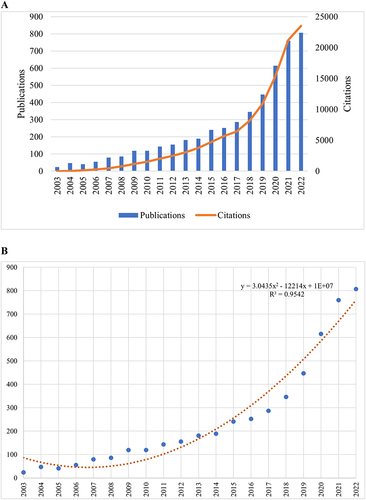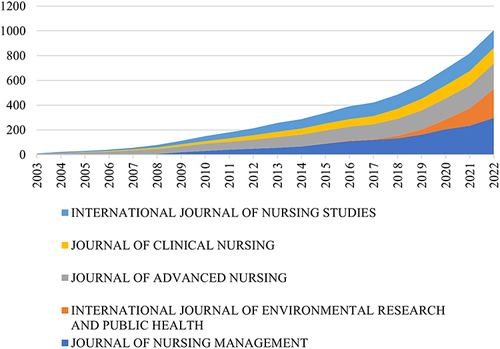Abstract
Objective
To investigate the current situation, trending subjects, and future directions in the field of burnout among nurses, and to serve as a resource for researchers conducting related research.
Methods
The bibliometric analysis was carried out using R package “bibliometrix”, bibliometric online analysis platform (https://bibliometric.com/) and VOSviewer (1.6.18).
Results
The leading countries that had a significant impact on this field were the USA and China. University of Pennsylvania was the most influential institution. Journal of Nursing Management was the top productive journal. Critical care, oncology care, acute care, and infectious disease care were more likely to lead to symptoms of burnout among nurses. “Mental health”, “job satisfaction”, “stress”, and “COVID-19” were the current hot topics in this field.
Conclusion
Our study not only provides a thorough outline to assist researchers in understanding the leading countries, institutions, journals, and potential collaborators, but it also examines the current and upcoming trends in this field and inspires researchers to select research directions.
Introduction
Registered nurses represent 59% of health professionals and are the largest occupational group among frontline healthcare workers worldwide, according to World Health Organization statistics.Citation1 As the backbone of the health system, however, nurses often suffer from mental health issues that come with a stressful work environment and long working hours.Citation2,Citation3 Suffering from mental health issues not only affects nurses’ health, but also directly contributes to their burnout.Citation4 Reduced personal accomplishment, emotional exhaustion, losing a positive outlook toward clients, or depersonalization are all signs of burnout.Citation5 Therefore, the emergence of burnout has a decidedly negative impact on the workforce and quality of healthcare, including workforce turnover, increased medical errors, and decreased patient satisfaction.Citation6–8 Therefore, there is an urgent need for well-established mechanisms to manage burnout among nurses so that these workforces can be resilient and improve well-being and efficiency at work.Citation9
Although burnout among nurses is increasingly recognized as a serious threat to patient safetyCitation10 and standard of care,Citation11 and has attracted the attention of health administrators, comprehensive bibliometric studies measuring and analyzing global scientific publications are still lacking. A bibliometric analysis of global publications in the field of nurse burnout may provide insights into the current state of the field to help guide future nursing management and promote high-quality research.Citation12 Therefore, to provide a comprehensive overview of research trends in burnout among nurses, highlight the contributions of leading countries, leading institutions, and authoritative scholars, and provide insight into potential future collaborations and research directions, we carried out the present study.
Materials and Methods
Data Source
The search was conducted in Web of Science on publications from January 1, 2003 to December 31, 2022, with a retrieval date of March 24, 2023. The retrieval strategy was as follows: TS = (nurse OR nurses OR nursing) AND TS = (burnout OR burn-out OR burn out). There were no limitations with respect to the language, and type of documents were limited to article. The included literature was checked manually by two authors independently.
Data Acquisition
Full records and cited references of the obtained publications were downloaded in BibTex or txt formats for further analysis. Moreover, information on the publications, including title, abstract, key words, country, author, institution, source, count of citations, cited references, and the 2021 IF of the top 10 core journals as well as the H-index of the top 10 most productive authors were recorded. Data extraction was conducted by two independent researchers.
Bibliometric Analysis
Bibliometric analysis was performed by R package “bibliometrix”Citation13 in R software (4.2.2), bibliometric online analysis platform (https://bibliometric.com/) and VOSviewer (1.6.18). In the present study, publication trends, author collaborative networks, institutional collaborative networks, and journal publication trends were constructed using R package “bibliometrix”. The National collaborative networks were analyzed using R package “bibliometrix” and Bibliometric online analysis platform (https://bibliometric.com/). Furthermore, co-occurrence of keywords and co-citation relationship of references were analyzed using VOSviewer.
Results
Analysis of Publications
Annual publications on burnout among nurses are presented in . Overall, the number of annual publications has shown a steady upward trend, from 24 in 2003 to 807 in 2022. In the last five years, publications in this area have shown a dramatic increase. The polynomial model fitting () (R2 = 0.9064) predicted that the number of publications is expected to rise further in the future. Similarly, the number of citations of publications also showed a steady increasing trend, from 4 in 2003 to 23,514 in 2022. Collectively, these findings suggest that research on burnout among nurses is a popular research focus and enters a stage of rapid development.
Analysis of Countries/Regions
A total of 110 countries spanning North America, Europe, Asia, Oceania, and South America were found to be involved in burnout among nurses, showing global collaboration trends (). Research in this field has been concentrated in developed countries, with the largest number of studies in North American and European countries. And China, as the world’s top economy, was also extensively involved in this area of research. The top three countries in terms of the number of publications were the USA, China, and Australia. The USA was the most frequently cited country, and England was the country with the highest average citations (). The USA and China constituted the most important multi-center cooperation network in this field ().
Table 1 The Top 10 Productive Countries/Regions
Figure 2 (A) The collaboration network shown on the world map, which was constructed via R package “bibliometrix” in R software. (B) Intercountry cooperation network, which was constructed via Bibliometric online analysis platform (https://bibliometric.com/).
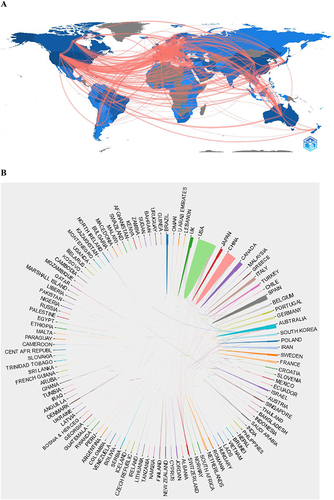
Analysis of Affiliations
A total of 5915 affiliations were involved in research on burnout among nurses. As shown in , University of Pennsylvania had the largest number of publications, followed by University of California System, and Harvard University. The University of Pennsylvania was the most frequently cited institution, followed by Western University (University of Western Ontario), and University of Toronto. Notably, the top 10 most prolific institutions are concentrated in North America and Europe. Furthermore, the University of Pennsylvania and University of Toronto constituted the most important multi-center cooperation network in this field ().
Table 2 The Top 10 Productive Affiliations
Figure 3 Collaboration between affiliations.

Analysis of Authors
A total of 17,294 authors contributed to research on burnout among nurses. As shown in , Aiken LH had the largest number of publications, followed by Laschinger HKS, and Wang L. Aiken LH was the most frequently cited author, followed by Sloane DM, and Laschinger HKS. Furthermore, Aiken LH was the author with the highest average citations, and H-index. Notably, the top 10 most prolific authors are concentrated in North America, China, and Europe. Furthermore, Aiken LH and Wang L constituted the most important multi-center cooperation network in this field ().
Table 3 The Top 10 Productive Authors
Figure 4 Collaboration between authors.
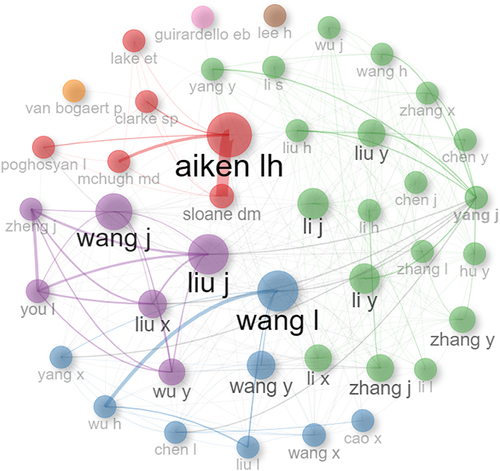
Analysis of Journals
A total of 709 journals were involved in research on burnout among nurses. As shown in , Journal of Nursing Management had the largest number of publications, followed by International Journal of Environmental Research and Public Health and Journal of Advanced Nursing. The International Journal of Nursing Studies was the most frequently cited journal, followed by Journal of Advanced Nursing and Journal of Nursing Management. Furthermore, the International Journal of Nursing Studies was the journal with the highest average citations, and IF. Additionally, the number of annual publications of the top five most active journals showed a steady upward trend ().
Table 4 The Top 10 Most Active Journals
Analysis of Co-Cited References
The number of cited references was as high as 107,886, so the minimum number of references cited was set to 100 to ensure their quality, and 35 articlesCitation14–48 were finally chosen for co-citation analysis. As shown in , cluster 1 (in red) primarily centered on the prevalence and influencing factors of burnout among nurses; cluster 2 (in green) centered on the measurement tools for assessing burnout; cluster 3 (in blue) centered on the impact of burnout on medical care.
Figure 6 Network map of co-cited references.
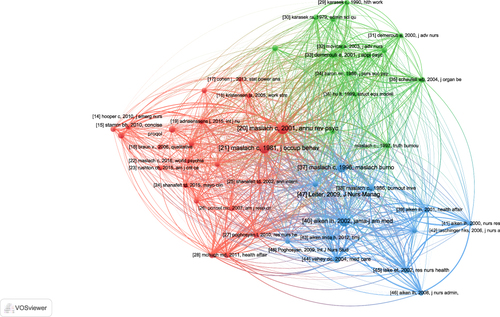
Analysis of Hotspots and Trends in Research
The six clusters formed by VOSviewer were composed of keywords that appeared more than 20 times. Cluster 1 (in red) and cluster 5 (in purple) centered on critical care, oncology care, long-term care; cluster 2 (in green), cluster 3 (in blue), cluster 6 (in light blue), and cluster 7 (in orange) centered on emotional mental health of nurse; cluster 4 (in yellow) centered on quality of life of nurses (). The most frequently occurring keywords after excluding nurse and burnout were “mental health”, “job satisfaction”, “stress”, and “covid-19”. Furthermore, “COVID-19” and “dpandemic” were the hot topics that have emerged recently ().
Figure 7 (A) Network map of keywords on burnout among nurses. (B) Trend of Topics over time.
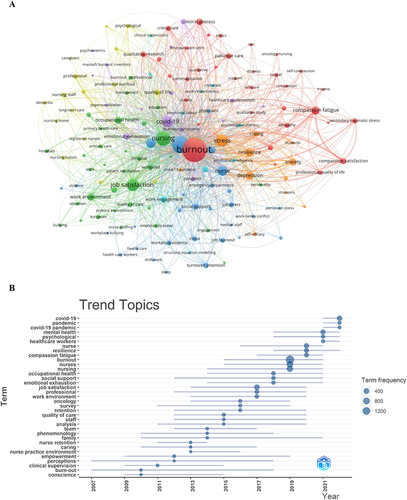
Discussion
One of the most significant issues in the medical field is burnout. Research on this syndrome in nurses, in particular, is of particular interest. With the recognition of this syndrome as an occupational disease, there are more and more reports of burnout in academic journals. The recent rise in production may be a reaction to the syndrome’s widespread prevalence in nursing.Citation49 This study revealed a steady increase in the number of publications, indicating that the issue of burnout among nurses is of interest to the international scientific community. In 2019, there was a significant increase in interest in burnout among nurses, which marked the turning point. Notably, COVID-19 was first reported in 2019 and its pandemic character caused worldwide panic.Citation50,Citation51 The most research on burnout among nurses has come from the USA and China. Five of the top 10 institutions in terms of publications resided in the USA. Furthermore, six of the top 10 authors in terms of publications came from the USA or China. These findings suggest that the USA and China are the leading countries in this field. Furthermore, the USA and China constituted the most important multi-center cooperation network in this field. Collaboration allows researchers to exchange information and expertise, which is essential for the advancement of the discipline. Therefore, closer collaborative networks of more countries, organizations and authors may help breakthroughs in this field. Most articles in this field were published in Journal of Nursing Management, indicating that it is by far the most popular journal and that more future research on burnout among nurses could be considered for publication in this journal. Analysis of co-cited references revealed that the prevalence and influencing factors of burnout among nurses, the measurement tools for assessing burnout, and the impact of burnout on medical care form the basis of research in this field. Keyword cluster analysis revealed that critical care, oncology care, long-term care, emotional mental health of nurses, quality of life of nurses were currently the key research directions in this field. Additionally, “mental health”, “job satisfaction”, “stress”, and “covid-19” were the current hot topics in this field. Furthermore, “COVID-19” and “dpandemic” were the hot topics that have emerged recently.
Nurses appear to be more vulnerable to burnout because of their constant, multifaceted exposure to patients, suffering, death, and lack of support from healthcare administrators.Citation52 The development of burnout is driven by environmental triggers, which are associated with personal factors (emotional exhaustion, compassion fatigue, moral distress, stress, and personality) and external factors (hospital environment and working conditions).Citation53 The emergence of burnout directly affects nurses’ mental, physical, and behavioral health, reducing their quality of life. More seriously, the safety and productivity of nursing staff is diminished, affecting the quality of patient care and contributing to turnover rates and nurse shortages in the clinic.Citation54,Citation55 Notably, the COVID-19 pandemic had adverse psychological consequences for most nurses, and the prevalence of burnout was able to grow rapidly.Citation56 Anxiety of getting sick, isolation periods, social distancing, and fear of the future all contributed to the burnout among nurses during the COVID-19 pandemic.Citation57,Citation58
Identifying and reducing burnout symptoms in nurses is a current challenge in nursing management. Preventing and eliminating the negative consequences of burnout among nurses is essential to avoid emotional exhaustion, increased irritability, and reduced job satisfaction, thereby affecting job reference and quality of care.Citation59 In their professional obligations, managers must adopt a leadership style that promotes nurses’ motivation, ensures a safe work environment, respects and listens to nurses, consciously builds teamwork with nurses, and enhances education to motivate nurses to acquire knowledge and skills.Citation60 In their relationships with patients and colleagues, managers must target their understanding of their employees’ psychological profiles and individualize interventions to prevent and/or manage the appearance of symptoms of burnout.Citation61 Meditation and positive spiritual coping are among the most powerful tools for dealing with the daily stresses of care in acute and critical care settings.Citation53 Complementary and alternative therapiesCitation62–64 can also be considered to improve the daily symptoms of stress. For managers, the active introduction and promotion of proven emotion management methods should be given sufficient attention.
The present study can provide some insight into the trends and hot spots in the field of burnout among nurses. However, some limitations must be acknowledged. First, due to limitations of the software used to analyze the data, only literature from the Web of Science was collected, while publications from other databases were not included, which may have resulted in the omission of some key hotspot information. Second, the limitation of using time and article type as inclusion criteria, and the exclusion of some types of publications in other formats and studies from 2023 may have led to the omission of some influential studies.
Conclusion
Although burnout among nurses has gained increasing attention in the nursing field, studies on the management of this occupational syndrome remain lacking. More international and cross-disciplinary cooperation is required to foster development in this field because the majority of the high-contributing institutions and authors were from high-income nations. Our study not only provides a thorough outline to assist researchers in understanding the leading countries, institutions, journals, and potential collaborators, but it also examines the current and upcoming trends in this field and inspires researchers to select research directions.
Disclosure
The authors report no conflicts of interest in this work.
Additional information
Funding
References
- Chen C, Meier ST. Burnout and depression in nurses: a systematic review and meta-analysis. Int J Nurs Stud. 2021;124:104099. doi:10.1016/j.ijnurstu.2021.104099
- Alasaari JS, Lagus M, Ollila HM, et al. Environmental stress affects DNA methylation of a CpG rich promoter region of serotonin transporter gene in a nurse cohort. PLoS One. 2012;7(9):e45813. doi:10.1371/journal.pone.0045813
- Dos Santos Damásio Silva D, Vieira da Silva Tavares N, Gomes Alexandre AR, et al. Depression and suicide risk among nursing professionals: an integrative review. Rev Esc Enferm USP. 2015;49(6):1023–1031. doi:10.1590/S0080-623420150000600020
- Cheng H, Liu G, Yang J, Wang Q, Yang H. Shift work disorder, mental health and burnout among nurses: a cross-sectional study. Nurs Open. 2023;10(4):2611–2620. doi:10.1002/nop2.1521
- Choi BS, Kim JS, Lee DW, et al. Factors associated with emotional exhaustion in South Korean nurses: a cross- sectional study. Psychiatry Invest. 2018;15(7):670–676. doi:10.30773/pi.2017.12.31
- De la Fuente-Solana EI, Gomez-Urquiza JL, Canadas GR, Albendin-Garcia L, Ortega-Campos E, Canadas-de la Fuente GA. Burnout and its relationship with personality factors in oncology nurses. Eur J Oncol Nurs. 2017;30:91–96. doi:10.1016/j.ejon.2017.08.004
- Duan-Porter W, Hatch D, Pendergast JF, et al. 12-month trajectories of depressive symptoms among nurses-contribution of personality, job characteristics, coping, and burnout. J Affect Disord. 2018;234:67–73. doi:10.1016/j.jad.2018.02.090
- Ji L, Zhou Q, Huang J, Lu D, et al. Macrophages in ulcerative colitis: a perspective from bibliometric and visual analysis. Heliyon. 2023;9(9):e20195. doi:10.1016/j.heliyon.2023.e20195
- Deible S, Fioravanti M, Tarantino B, Cohen S. Implementation of an integrative coping and resiliency program for nurses. Glob Adv Health Med. 2015;4(1):28–33. doi:10.7453/gahmj.2014.057
- Soósová MS. Association between nurses’ burnout, hospital patient safety climate and quality of nursing care. Cent Eur J Nurs Midw. 2021;12(1):245–256. doi:10.15452/cejnm.2020.11.0039
- Abraham CM, Zheng K, Norful AA, Ghaffari A, Liu J, Poghosyan L. Primary care nurse practitioner burnout and perceptions of quality of care. Nurs Forum. 2021;56(3):550–559. doi:10.1111/nuf.12579
- Danış F, Kudu E. The evolution of cardiopulmonary resuscitation: global productivity and publication trends. Am J Emerg Med. 2022;54:151–164. doi:10.1016/j.ajem.2022.01.071
- Aria M, Cuccurullo C. Bibliometrix: an R-tool for comprehensive science mapping analysis. J Informetr. 2017;11(4):959–975. doi:10.1016/j.joi.2017.08.007
- Hooper C, Craig J, Janvrin DR, Wetsel MA, Reimels E. Compassion satisfaction, burnout, and compassion fatigue among emergency nurses compared with nurses in other selected inpatient specialties. J Emerg Nurs. 2010;36(5):420–427. doi:10.1016/j.jen.2009.11.027
- Stamm BH. The Concise ProQOL Manual: the concise manual for the Professional Quality of Life Scale, 2 nd Edition; 2010. Available from: https://proqol.org/proqol-manual. Accessed April 18, 2024.
- Braun V, Clarke V. Using thematic analysis in psychology. Qual Res Psychol. 2008;3(2):77–101. doi:10.1191/1478088706qp063oa
- Cohen J. Statistical Power Analysis for the Behavioral Sciences. 2nd ed. Routledge; 1988. doi:10.4324/9780203771587
- Kristensen TS, Borritz M, Villadsen E, Christensen KB. The Copenhagen Burnout Inventory: a new tool for the assessment of burnout. Work Stress. 2005;19(3):192–207. doi:10.1080/02678370500297720
- Adriaenssens J, De Gucht V, Maes S. Determinants and prevalence of burnout in emergency nurses: a systematic review of 25 years of research. Int J Nurs Stud. 2015;52(2):649–661. doi:10.1016/j.ijnurstu.2014.11.004
- Maslach C, Schaufeli WB, Leiter MP. Job burnout. Annu Rev Psychol. 2001;52(1):397–422. doi:10.1146/annurev.psych.52.1.397
- Maslach C, Jackson SE. The Measurement of experienced burnout. J Organizational Behav. 1981;2(2):99–113. doi:10.1002/job.4030020205
- Maslach C, Leiter MP. Understanding the burnout experience: recent research and its implications for psychiatry. World Psychiatry. 2016;15(2):103–111. doi:10.1002/wps.20311
- Rushton CH, Batcheller J, Schroeder K, Donohue P. Burnout and resilience among nurses practicing in high-intensity settings. Am J Crit Care. 2015;24(5):412–420. doi:10.4037/ajcc2015291
- Shanafelt TD, Hasan O, Dyrbye LN, et al. Changes in burnout and satisfaction with work-life balance in physicians and the General US Working Population Between 2011 and 2014. Mayo Clin Proc. 2015;90(12):1600–1613. doi:10.1016/j.mayocp.2015.08.023
- Shanafelt TD, Bradley KA, Wipf JE, Back AL. Burnout and self-reported patient care in an internal medicine residency program. Ann Intern Med. 2002;136(5):358–367. doi:10.7326/0003-4819-136-5-200203050-00008
- Poncet MC, Toullic P, Papazian L, et al. Burnout syndrome in critical care nursing staff. Am J Respir Crit Care Med. 2007;175(7):698–704. doi:10.1164/rccm.200606-806OC
- Poghosyan L, Clarke SP, Finlayson M, Aiken LH. Nurse burnout and quality of care: cross-national investigation in six countries. Res Nurs Health. 2010;33(4):288–298. doi:10.1002/nur.20383
- McHugh MD, Kutney-Lee A, Cimiotti JP, Sloane DM, Aiken LH. Nurses’ widespread job dissatisfaction, burnout, and frustration with health benefits signal problems for patient care. Health Aff. 2011;30(2):202–210. doi:10.1377/hlthaff.2010.0100
- Karasek RA, Tores T. Healthy work: stress, productivity, and the reconstruction of working life; 1990.
- Karasek RA, Demands J. Job decision latitude and mental strain: implications for job redesign; 1979.
- Demerouti E, Bakker AB, Nachreiner F, Schaufeli WB. A model of burnout and life satisfaction amongst nurses. J Adv Nurs. 2000;32(2):454–464. doi:10.1046/j.1365-2648.2000.01496.x
- McVicar A. Workplace stress in nursing: a literature review. J Adv Nurs. 2003;44(6):633–642. doi:10.1046/j.0309-2402.2003.02853.x
- Demerouti E, Bakker AB, Nachreiner F, Schaufeli WB. The job demands-resources model of burnout. J Appl Psychol. 2001;86(3):499–512. doi:10.1037/0021-9010.86.3.499
- Baron RM, Kenny DA. The moderator-mediator variable distinction in social psychological research: conceptual, strategic, and statistical considerations. J Pers Soc Psychol. 1986;51(6):1173–1182. doi:10.1037/0022-3514.51.6.1173
- Schaufeli WB, Bakker AB. Job demands, job resources, and their relationship with burnout and engagement: a multi‐sample study. J Organizational Behav. 2004;25(3):293–315. doi:10.1002/job.248
- Li‐tze H, Bentler PM. Cutoff criteria for fit indexes in covariance structure analysis: conventional criteria versus new alternatives. Struct Equat Model. 1999;6(1):1–55. doi:10.1080/10705519909540118
- Maslach C, Leiter MP. The Truth About Burnout: How Organizations Cause Personal Stress and What to Do About It. Jossey-Bass; 1997. Available from: https://psycnet.apa.org/record/1997-36453-000. Accessed April 18, 2024.
- Maslach C. Stress, burnout, and workaholism. In: Kilburg RR, Nathan PE, Thoreson RW, editors. Professionals in Distress: Issues, Syndromes, and Solutions in Psychology. American Psychological Association; 1986:53–75. doi:10.1037/10056-004
- Aiken LH, Clarke SP, Sloane DM, et al. Nurses’ reports on hospital care in five countries. Health Aff. 2001;20(3):43–53. PMID: 11585181. doi:10.1377/hlthaff.20.3.43
- Aiken LH, Clarke SP, Sloane DM, Sochalski J, Silber JH. Hospital nurse staffing and patient mortality, nurse burnout, and job dissatisfaction. JAMA. 2002;288(16):1987–1993. doi:10.1001/jama.288.16.1987
- Aiken LH, Patrician PA. Measuring organizational traits of hospitals: the Revised Nursing Work Index. Nursing Research. 2000;49(3):146–153. doi:10.1097/00006199-200005000-00006
- Spence Laschinger HK, Leiter MP. The impact of nursing work environments on patient safety outcomes: the mediating role of burnout/engagement. J Nurs Adm. 2006;36(5):259–267. doi:10.1097/00005110-200605000-00019
- Aiken LH, Sermeus W, Van den Heede K, et al. Patient safety, satisfaction, and quality of hospital care: cross sectional surveys of nurses and patients in 12 countries in Europe and the United States. BMJ. 2012;344:e1717. doi:10.1136/bmj.e1717
- Vahey DC, Aiken LH, Sloane DM, Clarke SP, Vargas D. Nurse burnout and patient satisfaction. Med Care. 2004;42(2 Suppl):II57–II66. doi:10.1097/01.mlr.0000109126.50398.5a
- Lake ET. Development of the practice environment scale of the Nursing Work Index. Res Nurs Health. 2002;25(3):176–188. doi:10.1002/nur.10032
- Aiken LH, Clarke SP, Sloane DM, Lake ET, Cheney T. Effects of hospital care environment on patient mortality and nurse outcomes. J Nurs Adm. 2008;38(5):223–229. doi:10.1097/01.NNA.0000312773.42352.d7
- Leiter MP, Maslach C. Nurse turnover: the mediating role of burnout. J Nurs Manag. 2009;17(3):331–339. doi:10.1111/j.1365-2834.2009.01004.x
- Poghosyan L, Aiken LH, Sloane DM. Factor structure of the Maslach burnout inventory: an analysis of data from large scale cross-sectional surveys of nurses from eight countries. Int J Nurs Stud. 2009;46(7):894–902. doi:10.1016/j.ijnurstu.2009.03.004
- Álvarez L, Mori P, Gómez MC. Síndrome de burnout y satisfacción laboral en enfermeras españolas en tiempo de crisis económica [Burnout Syndrome and job satisfaction among Spanish nurses at a time of economic crisis]. Metas Enferm. 2019;22:50–58. Spanish.
- Xiao G, Wang S, Wang R, et al. “Three medicines and three formulas” in COVID-19: from bench to bedside. Acupunct Herbal Med. 2023;3(4):309‒322. doi:10.1097/HM9.0000000000000082
- Wang L, Hu X, Geng L. Multi-effective characteristics and advantages of acupuncture in COVID-19 treatment. Acupunct Herbal Med. 2023;3(2):83‒95. doi:10.1097/HM9.0000000000000062
- Ten HY, Brouwer J, Kunnen S. Turnover prevention: the direct and indirect association between organizational job stressors, negative emotions and professional commitment in novice nurses. J Adv Nurs. 2020;76(3):836–845. doi:10.1111/jan.14281
- De Diego-Cordero R, Iglesias-Romo M, Badanta B, Lucchetti G, Vega-Escaño J. Burnout and spirituality among nurses: a scoping review. Explore. 2022;18(5):612–620. doi:10.1016/j.explore.2021.08.001
- Alenezi A, McAndrew S, Fallon P. Burning out physical and emotional fatigue: evaluating the effects of a programme aimed at reducing burnout among mental health nurses. Int J Ment Health Nurs. 2019;28(5):1042–1052. PMID: 31231965. doi:10.1111/inm.12608
- Kelly LA, Gee PM, Butler RJ. Impact of nurse burnout on organizational and position turnover. Nurs Outlook. 2021;69(1):96–102. doi:10.1016/j.outlook.2020.06.008
- Chaudhary P, Payal NP, Pooja RP, et al. Perceived risk of infection, ethical challenges and motivational factors among frontline nurses in Covid-19 pandemic: prerequisites and lessons for future pandemic. BMC Nurs. 2024;23(1):5. doi:10.1186/s12912-023-01653-7
- Kumar R, Das A, Singh V, Gupta PK, Bahurupi YA. Rapid survey of psychological status of health‑care workers during the early outbreak of COVID‑19 pandemic: a single‑centre study at a tertiary care hospital in Northern India. J Med Evid. 2021;2(3):213–218. doi:10.4103/JME.JME_8_21
- Dharra S, Kumar R. Promoting mental health of nurses during the coronavirus pandemic: will the rapid deployment of nurses’ training programs during COVID-19 improve self-efficacy and reduce anxiety? Cureus. 2021;13(5):e15213. doi:10.7759/cureus.15213
- Adriaenssens J, De Gucht V, Maes S. Causes and consequences of occupational stress in emergency nurses, a longitudinal study. J Nurs Manag. 2015;23(3):346–358. doi:10.1111/jonm.12138
- Silva VLDS, Camelo SHH, Soares MI, et al. Leadership practices in hospital nursing: a self of manager nurses. Revista da Escola de Enfermagem da USP. 2017;51:e03206.
- Cao X, Naruse T. Effect of time pressure on the burnout of home‐visiting nurses: the moderating role of relational coordination with nursing managers. Japan J Nurs Sci. 2019;16(2):221–231. doi:10.1111/jjns.12233
- Huang J, Shen M, Qin X, Guo W, Li H. Acupuncture for the treatment of tension-type headache: an overview of systematic reviews. Evid Based Complement Alternat Med. 2020;2020:4262910. doi:10.1155/2020/4262910
- Huang J, Liu H, Chen J, Cai X, Huang Y. The effectiveness of tai chi in patients with breast cancer: an overview of systematic reviews and meta-analyses. J Pain Symptom Manage. 2021;61(5):1052–1059. doi:10.1016/j.jpainsymman.2020.10.007
- Huang J, Chen T, Zhang J, Ma X, Wang F, Tang X. Overlapping symptoms of functional gastrointestinal disorders: current challenges and the role of traditional Chinese medicine. Am J Chin Med. 2023;51(4):833–857. doi:10.1142/S0192415X23500398

